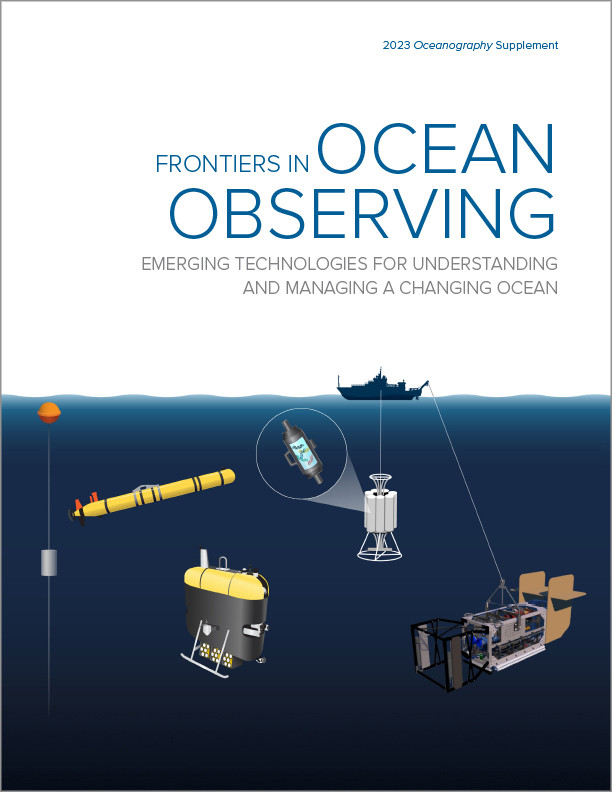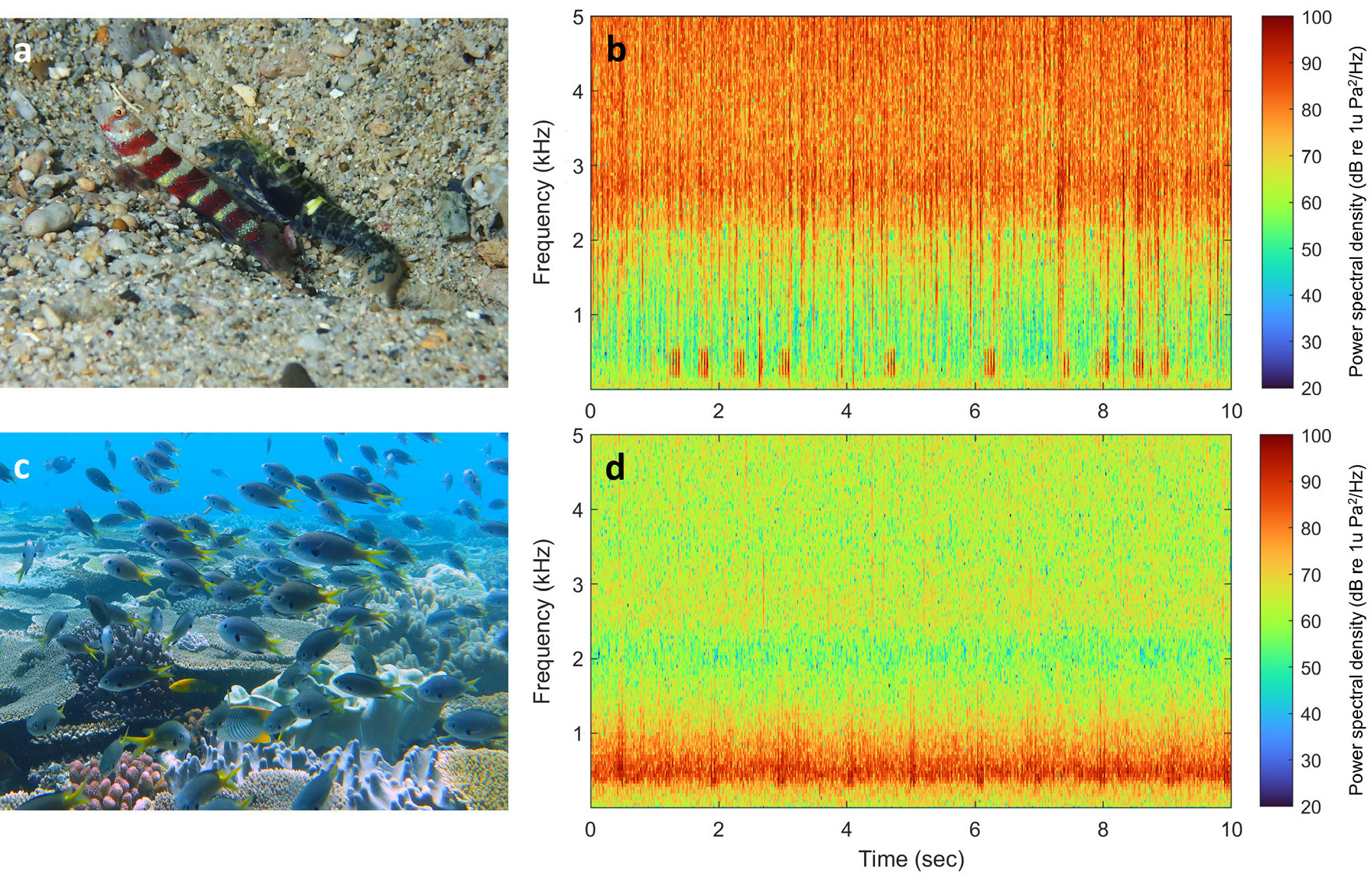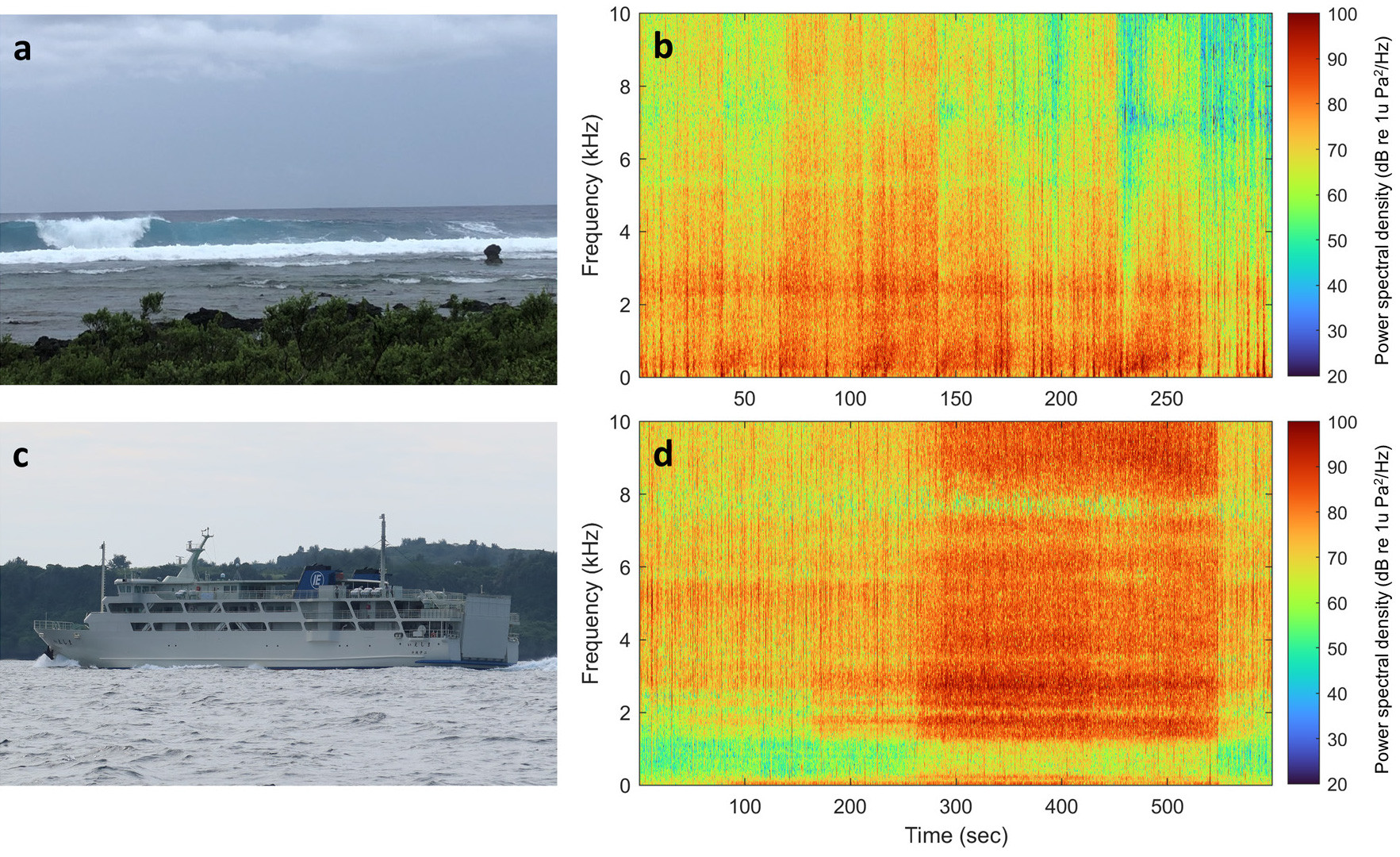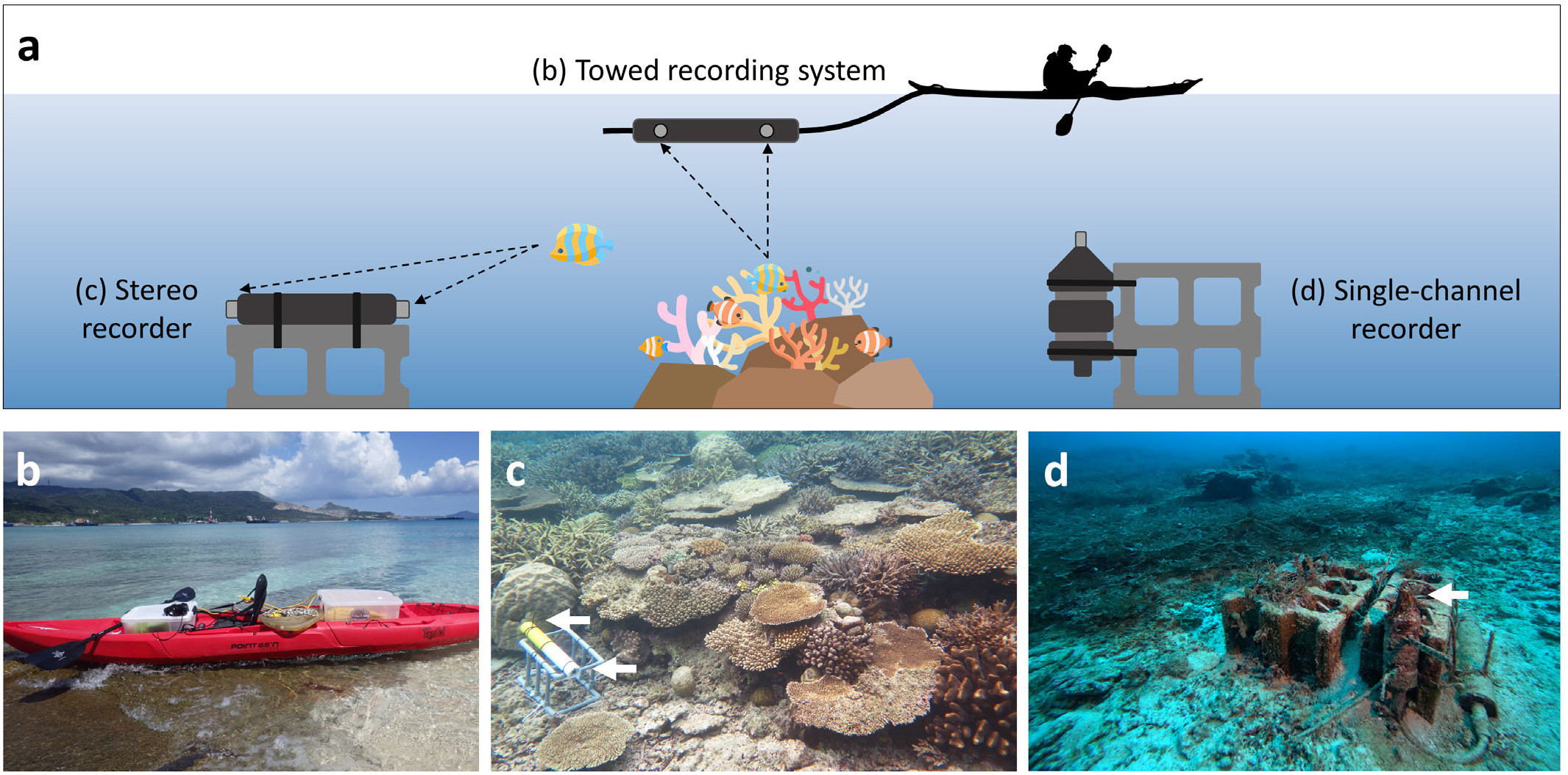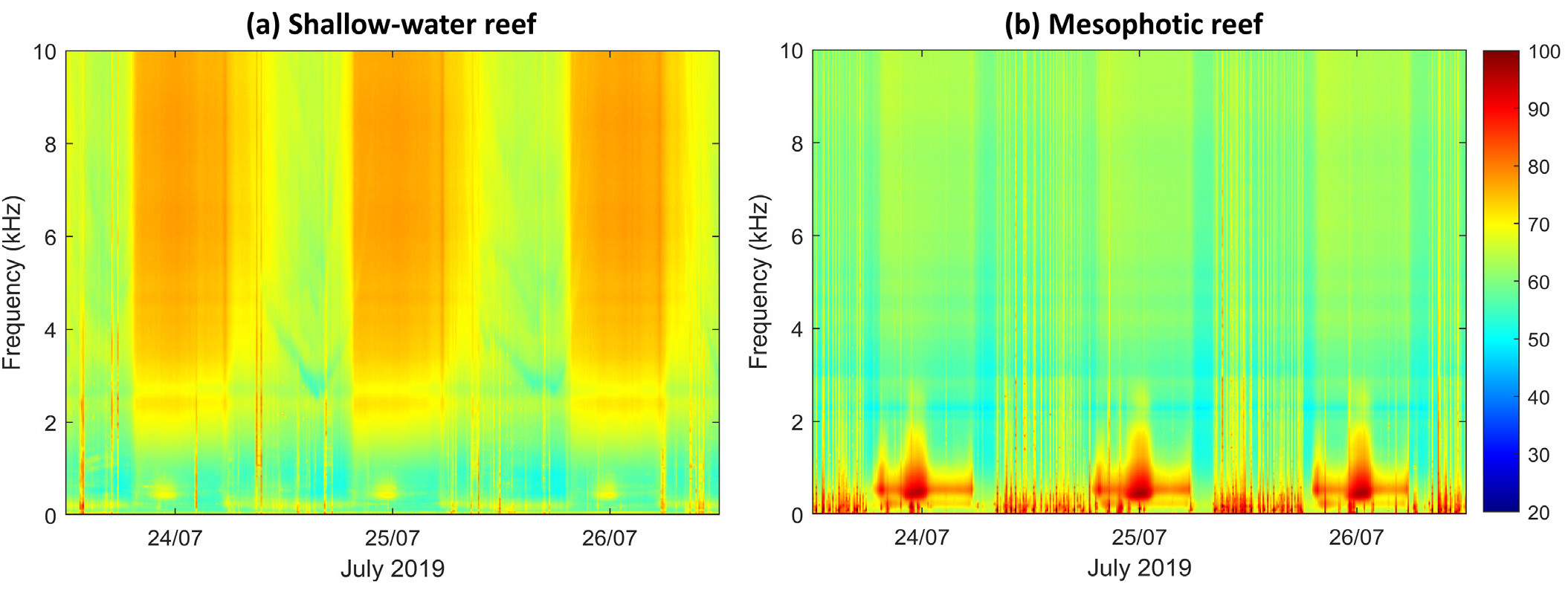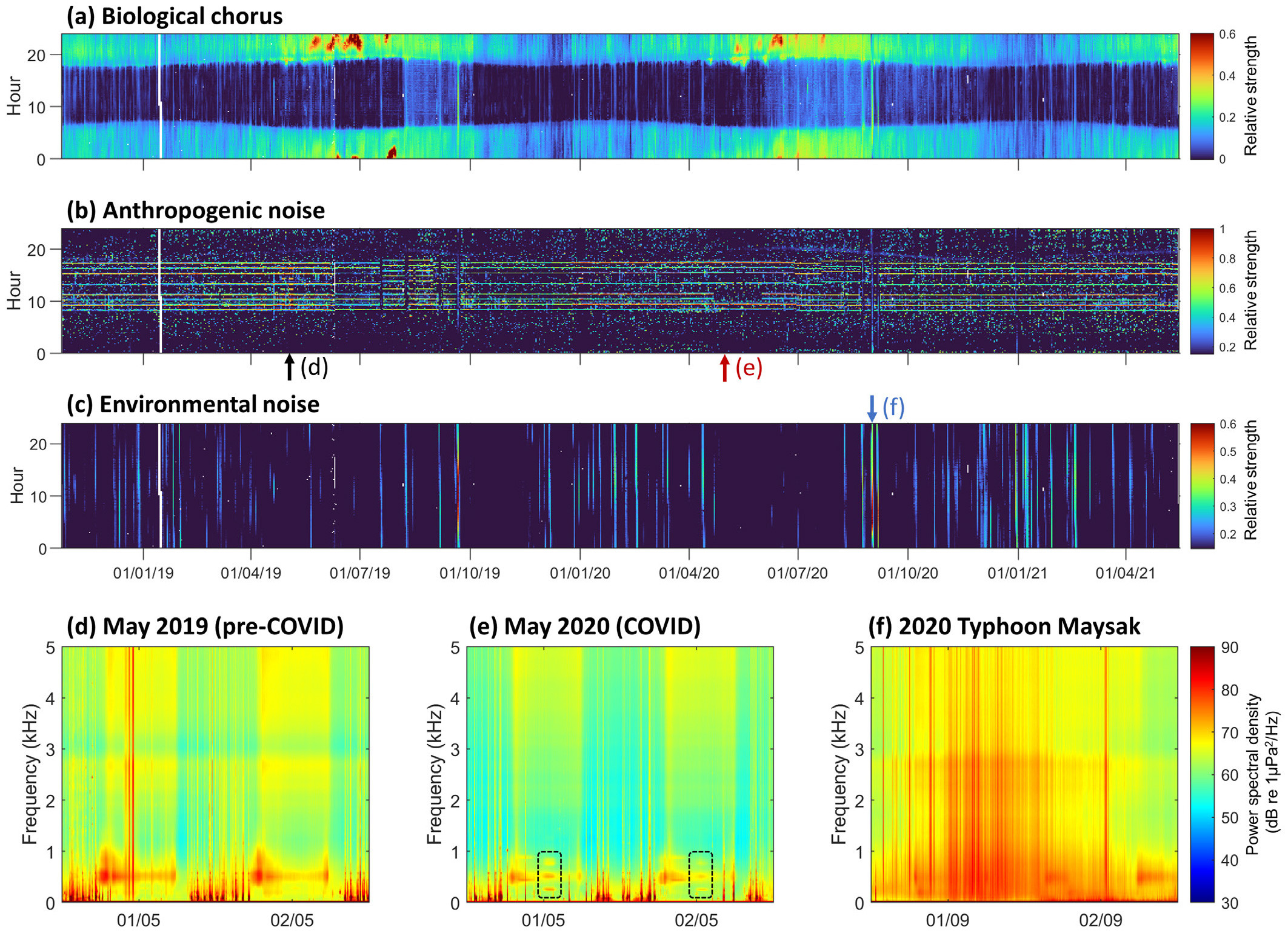Full Text
Coral reefs are among the world’s most diversified marine ecosystems. While their rich biodiversity is essential to many social and economic activities, they face unprecedented cumulative impacts from climate change and anthropogenic development. Aligning governance structures with ecological processes has become key to sustaining ecosystem services. Nevertheless, a major obstacle to informing decision-making is the lack of empirical data on interacting ecological and social processes. Therefore, novel methods for facilitating the assessment of coral reef social-ecological systems are necessary.
Sounds are ubiquitous in coral reef ecosystems, where many reef-associated animals intentionally or unintentionally produce sounds (Mooney et al., 2020). In addition, geophysical events (e.g., wind, waves, and rain) and anthropogenic activities (e.g., shipping, fishing, and scuba diving) generate perceptible sounds (Lin et al., 2021; Simmons et al., 2021). Listening to underwater soundscapes—the mixture of biophony, geophony, and anthropophony—opens a new avenue for studying the ecological and human dimensions of coral reef ecosystems (Figure 1).
|
|
Sounds of Coral Reef Biodiversity
In coral reef ecosystems, large aggregations of snapping shrimps produce pervasive broadband snaps dominating frequencies >2 kHz (Figure 2a,b) during territorial behavior, foraging, and social interactions (Anker et al., 2006). Various reef-associated fishes, such as damselfish, surgeonfish, and butterflyfish, also generate pulsed sounds of a few hundred hertz (Figure 2b,c) during agonistic and reproductive behaviors, as well as scraping of reef substrate during feeding behaviors (Tricas and Boyle, 2014). Fish sounds can form acoustic mass phenomena in spawning aggregations when multiple calls coalesce into a long-duration chorus (Erisman and Rowell, 2017), turning a coral reef into a concert hall for soniferous fish (Figure 2d). The diverse arrays of biotic sounds from healthy coral reefs create unique soundscapes that can function as habitat cues for the larvae of coral, crustaceans, and reef-associated fish to settle (Simpson et al., 2005; Duarte et al., 2021). Because of the phonotaxis (the movement of an organism in relation to a sound source) of marine larvae toward these cacophonous reefs, reef sounds have been considered a potentially useful indicator of coral reef health (Lamont et al., 2022b).
|
|
Monitoring soundscapes has the advantage of providing a rapid assessment of a coral reef ecosystem. Although there is still much debate about the selection of acoustic analysis methods, there are ongoing efforts to link acoustic indices to trends in marine biodiversity and ecosystem health (Pieretti and Danovaro, 2020). For instance, measurements of soundscape complexity—indicators of biotic sound diversity—can be used to differentiate between healthy and degraded coral reefs (Lamont et al., 2022b). In addition, analyzing the diurnal and seasonal variations of biological choruses can reveal the phenological patterns of coral reef ecosystems (Lin et al., 2021). While more field studies are needed to fully understand the application and limitations of acoustic indices, investigating spatiotemporal changes in soundscapes will help researchers and managers assess ecological processes crucial for coral reef biodiversity.
Sounds of Environmental and Anthropogenic Stressors
Soundscapes also yield information about the effects of environmental and anthropogenic stressors on coral reef ecosystems. Tropical storms can cause severe damage in shallow-water coral reefs through storm-force waves, fast-moving debris, and heavy sediment deposits (Cheal et al., 2017). Estimating storm impact using meteorological data may be less accurate at fine spatial scales, particularly for reefs protected by local topography or those located deeper, such as mesophotic reefs (30–150 m depth). However, underwater sounds recorded on reefs can provide direct observations of environmental disturbance associated with wave action and moving debris (Figure 3a,b), enabling estimation of the extent of physical damage caused by storms. Post-storm changes in biotic sounds may also be useful for assessing the resilience of soniferous animals to changes in benthic habitat and environmental conditions resulting from storm damage (Simmons et al., 2021).
Open-circuit scuba diving, boating, jet skiing, and many other aquatic recreational activities generate high-intensity broadband noise (Ferrier-Pagès et al., 2021). Frequent maritime shipping traffic, particularly in densely populated coastal areas, also produces noise that creates a sort of “acoustic fog” that masks natural soundscapes (Figure 3c,d). Anthropogenic noise can directly influence the physiology and behavior of marine organisms or indirectly weaken ecosystem resilience through acoustic interference with marine larvae dispersion as it masks habitat soundscapes (Duarte et al., 2021). Despite its profound impacts on ocean biodiversity, noise pollution has received little attention in coral reef conservation.
|
|
Through the analysis of biotic and abiotic sounds, soundscapes can be transformed into indicators of biodiversity change, environmental perturbation, and anthropogenic interference (Lin et al., 2021). Such indicators represent a promising tool for investigating the interactions between ecological and social processes. In practice, the use of soundscapes in ecosystem assessment is often limited by the need for long-term observations. Moreover, our understanding of soundscape dynamics and associated mechanisms remains highly speculative due to insufficient spatiotemporal coverage and a lack of techniques for identifying distinct sound sources (Mooney et al., 2020; Parsons et al., 2022).
Monitoring Coral Reef Soundscapes in Okinawa, Japan
Recent developments in commercially available audio hardware offer opportunities to monitor soundscapes at scale (Lamont et al., 2022a). While single-channel audio remains the most popular choice for long-term soundscape monitoring, multichannel systems can be used for direction finding (employing stereo recorders with two hydrophones) or source localization (three or more hydrophones), providing spatial information to study the behavior of marine soniferous animals (Figure 4a). The scale of spatial coverage can also be increased by installing audio recording systems on drifting buoys and unmanned surface and underwater vehicles or by towing them behind mobile platforms (Lillis et al., 2018; Luczkovich and Sprague, 2022).
In 2017, a research project focusing on coral reef soundscapes off Sesoko Island in Okinawa, Japan, was initiated for the observation of shallow-water and mesophotic coral ecosystems (Lin et al., 2021). The shallow-water site is on Sesoko Island’s southeast shore, where a flat reef dominated by tabular Acropora corals is located (Singh et al., 2022). Two other deeper sites are close to a large mesophotic ecosystem located on a flat plateau north of Sesoko Island (Sinniger et al., 2022).
To map the spatial variation of coral reef soundscapes, a Towed Aquafeeler recording system (AquaSound, Kobe, Japan) was towed behind a tandem kayak (Figure 4b). Due to their low-noise characteristic, kayaks provide suitable research platforms for mapping the distribution of soniferous animals such as snapping shrimp and damselfish. In addition, AUSOMS-mini stereo recorders (AquaSound, Kobe, Japan) were used to monitor the soundscape phenology patterns of shallow-water and mesophotic reefs (Figure 4c). After initial success with soundscape monitoring, SoundTrap 300 STD recorders (Ocean Instruments, Auckland, New Zealand) were used for the long-term monitoring of coral reef soundscapes after the summer of 2018 (Figure 4d).
|
|
These autonomous recording devices generated a substantial amount of acoustic data that reflect the spatiotemporal dynamics of coral reef soundscapes (approximately one terabyte of audio recordings per year for one recording site using a sampling frequency of 48 kHz and a recording duty cycle of 5 min every 10 min). Because of their long temporal coverage and high-resolution sampling, soundscape recordings can fill observation gaps caused by poor weather conditions, thereby serving as a complementary tool to other survey methods. Monitoring soundscapes also offers a data-driven approach to acoustically observing difficult-to-reach coral reefs at mesophotic depths.
Analyzing Soundscape Dynamics
Advances in audio signal processing have enabled the application of long-term spectrograms for visualizing long-duration recordings, so that researchers can inspect soundscape changes in time and frequency domains without listening to the entire audio data set (Lin et al., 2021). This approach provides an intuitive method for comparing soundscapes from different coral reefs or environmental conditions. For example, long-term spectrograms showed that snapping shrimp sounds were predominant at shallow-water reefs (Figure 5a), but fish choruses and shipping noise were the primary contributors to the soundscapes of mesophotic reefs in Sesoko Island waters (Figure 5b).
|
|
Identifying the occurrence of biophony, geophony, and anthropophony is essential for using soundscapes to assess ecological and social processes. To analyze soundscape dynamics, we used soundscape_IR, an open-source Python toolbox for soundscape information retrieval (Sun et al., 2022), to perform source separation on long-term spectrograms. Because biological choruses, shipping noise, and wave noise have distinct diurnal and seasonal patterns in long-term spectrograms, a source separation model can effectively learn source-specific temporal activations and calculate their relative intensities. Soundscape recordings can therefore be converted into metrics that describe temporal variations in biophony, geophony, and anthropophony.
Use of soundscapes in marine biodiversity assessment is a rapidly developing field. In addition to the techniques of long-term spectrogram and source separation, there are ongoing efforts to identify marine animal sounds by leveraging artificial intelligence (Mooney et al., 2020). Although acoustics-based species identification remains challenging due to the lack of a comprehensive reference library for marine animal vocalizations (Parsons et al., 2022), digitally stored audio recordings can still be revisited in the future when better techniques are available.
Soundscape Dynamics Reveal Social-Ecological Changes
Using the techniques of long-term spectrogram and source separation (Lin et al., 2021), we visualized the changes in biological chorus, anthropogenic noise, and environmental noise off Sesoko Island from October 2018 to May 2021 (Figure 6a–c). With the three acoustic dimensions, we observed the broad range of uses of soundscapes to study coral reef social-ecological systems. According to the diurnal and seasonal variations in biological choruses, the activities of soniferous animals were mainly influenced by daylight hours and seasonal environments. In addition, a diverse array of nighttime fish choruses was detected annually from May to August, with intensities that varied with the tide (Figure 6a). These phenological patterns can stimulate new insights into the ecology of reef fauna, such as diel feeding behavior, lunar synchronization in reproduction, and seasonal recruitment—ecological processes that are key to understanding the dynamics of coral reef biodiversity.
|
|
During the 2019 Golden Week—one of the busiest Japanese holiday seasons—coral reef soundscapes off Sesoko Island were heavily influenced by shipping noise, particularly that produced by daytime ferries transporting large numbers of tourists (Figure 6d). In comparison, the noise produced by ferries and fishing vessels was reduced during the 2020 Golden Week when the first nationwide pandemic state of emergency was announced (Figure 6e). The observed change in soundscapes reflects the unprecedented situation faced by local communities due to the COVID-19 pandemic and related lockdown directives. During the COVID-19 anthropause (Rutz et al., 2020), new fish sounds were detected in the nighttime chorus. Although we cannot be sure whether the change was a direct response to reduced noise, the high-resolution acoustic data offer unique opportunities to investigate potential interactions between social and ecological networks.
Coral reefs in subtropical waters are subject to seasonal disturbances. The variation in environmental noise clearly shows that coral reefs in Okinawa waters are affected by two annual periods of higher sea state: the summer typhoon season and the winter monsoon season (Figure 6c). Depending on the intensity and size of a typhoon, high-intensity waves can significantly elevate noise levels (Figure 6f). For typhoons that had severe impacts, biological choruses and anthropogenic noise were reduced in post-typhoon periods, a finding that likely reflects the social-ecological response to deteriorating ocean conditions. Furthermore, environmental noise during the winters of 2018–2021 showed an annual increase in monsoon-induced wave noise, which is consistent with Okinawa’s long-term wind records (Singh et al., 2022). Although monsoon effects on subtropical coral reefs are rarely discussed, information on environmental noise can foster an understanding of regional climate conditions that will support future investigations regarding the adaptation of coral reef biodiversity in response to the changing climate.
Listening to the Ocean for Better Conservation Planning
Although current research on coral reef soundscapes is still in its infancy, the emerging potential of acoustic tools for revealing ecological and anthropogenic dynamics in marine ecosystems holds promise for improving the management of coral reef social-ecological systems. One potential method is to use soundscapes as underwater sensing platforms to assess the effects of environmental and anthropogenic stressors on coral reef ecosystems; effects of interest include the decline of biotic sounds in response to increasing fishing and tourist activities, and the recovery of acoustic activity after bleaching events or oil spills (Mooney et al., 2020). Audio recordings alone cannot document every social-ecological process, but they can still provide managers and social actors with acoustic indicators of ecosystem dynamics useful for decision-making. For example, the long-term soundscape monitoring of coral reefs could help identify changes in reef ecosystem health and biodiversity, providing early warning signs of reef degradation to managers, who can then take appropriate action to restrict human activities and plan restoration strategies.
Another method by which conservation management may be improved is tracking changes in coral reef soundscapes over multiple sites (Lin et al., 2021; Lamont et al., 2022b). Under the impact of ocean warming, global shallow-water coral reefs are expected to become substantially degraded. Mapping the spatial heterogeneity of soundscapes could facilitate the identification of coral reefs less susceptible to recurrent bleaching events and those in deeper areas that serve as refuges for shallow-water reef animals. With further work to demonstrate the use of soundscapes in predicting reef degradation and recovery processes, this acoustic technique may provide a more efficient method for assessing climate impacts on global coral reefs and guiding future research and conservation investments.
Using soundscapes to identify the sources of anthropogenic noise and its distribution may also improve marine spatial planning (Williams et al., 2015). For example, if frequent noise from shipping traffic is detected in a marine protected area, it may be necessary to rearrange shipping routes or implement speed limits to reduce noise that interferes with marine fauna within the protected area (Nedelec et al., 2022). In addition, monitoring soundscapes offers opportunities to gather evidence of illegal extraction activities, such as blast fishing. Such information is critical for guiding enforcement decisions, particularly in remote areas where patrolling efforts are limited.
In the Anthropocene, anthropogenic noise has become a global-scale pollutant that may broadly impact marine life at all trophic levels (Duarte et al., 2021). Despite efforts to restore coral reef biodiversity, results may be compounded by pervasive underwater noise (Ferrier-Pagès et al., 2021). Global research on how social development alters coral reef soundscapes and approaches for conserving soundscapes are therefore critical for meeting the Target 14.1 Sustainable Development Goal.
We urge the establishment of a global collaborative monitoring network of soundscapes to develop broader managing strategies for coral reef conservation. This is in line with the scientific need to measure essential ocean variables recently outlined by the Global Ocean Observing System (Howe et al., 2019). Furthermore, such a global soundscape monitoring network will be essential for a more comprehensive understanding of ecosystem dynamics—a critical step toward effective prediction of how climate change and social development impact coral reef social-ecological systems.

